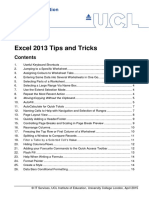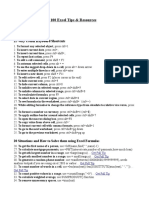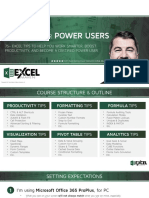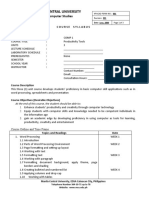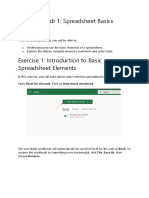Quick Excel Tips
Charts and Graphics
1. Your ability to compare areas isn't as good as your ability to compare lengths, so
use bar graphs instead of pie graphs if possible.
2. To align objects to the corners of the grid in Excel, hold down the ALT key as you
draw, move, or resize objects.
3. If you have a hard time selecting a series or object in an Excel chart, try using the
drop-down box in the Chart toolbar.
4. Link text in chart titles, axis labels, data labels, and text boxes to a cell by
entering =A1 in the formula bar after selecting the object.
5. Create a timeline using an X-Y chart, data labels, and vertical error bars.
6. Create a Dot Plot or Dot Chart in Excel using the REPT() formula
� Quick Excel Tips
Special Features
1. Create a Drop-Down List within a Cell using Data Validation.
2. Named Ranges as Bookmarks: You can create a bookmark within a large
spreadsheet by naming a cell. Then use CTRL+G to quickly navigate to that cell.
You can create a hyperlink to navigate to a bookmark (press CTRL+K and click
on Bookmark).
3. Autoshapes as Navigation Buttons: You can use an autoshape to create a
button and then apply a hyperlink to that button to link to a bookmark, another
worksheet, or even an external web page.
4. Named Constants: You can create a Name for a constant or formula without
actually referencing a range. Go to Insert > Name > Define (Excel 2003) or
Formulas > Name Manager (Excel 2010).
5. What-If Scenarios: If you have a mathematical model, consider using Scenarios
to store and analyze different what-if scenarios. (go to Tools > Scenarios in Excel
2003 or Data > What-If Analysis > Scenario Manager in Excel 2010)
6. Grouping and Outlining: You can use the Data > Group and Outline feature in
Excel to expand and contract groups of rows and columns.
7. Insert a ✔ by pressing ⊞+. to open the Windows 10 Emoji Panel or by going to
Insert > Symbol and changing the font to "Segoe UI Symbol".
8. Add an AutoCorrect Exception to prevent "MPa" from changing to "Mpa" (Tools >
AutoCorrect Options in Excel 2003 or File > Options > Proofing in Excel 2010)
�9. Insert special symbols like °, ², ∂ and µ quickly by adding custom Autocorrect
entries.
10.Goal Seek: Set an output (calculated) cell to a specific value by changing an
input cell automatically using Excel's Goal Seek feature.
11.Remove Duplicates from a list by selecting the cells then go to Data > Filter >
Advanced Filter, and check Unique Records Only.
12.Show the Developer tab in Excel 2016: Go to File > Options > Customize
Ribbon and select the "Developer" tab option
13.Solver Add-In: In Excel 2010+, enable the Solver Add-In by going to Developer
> Excel Add-Ins. Solver will show up in the Data ribbon. In Excel 2003 go to Tools
> Add-Ins, the Solver will show up under Tools.
14.Customizable Drop-Down Lists: Use data validation lists that reference named
ranges to create lists that you can customize easily
15.Named Ranges: If you set the Zoom to 39% or less, Named Ranges consisting
of 2 or more adjacent cells will be shown outlined.
16.Pictures in Comments: You can display a picture as the background in a
comment (Format Comment > Colors and Lines > Fill - Color > Fill Effects >
Picture)







